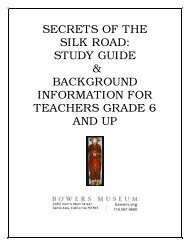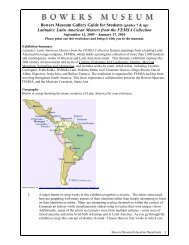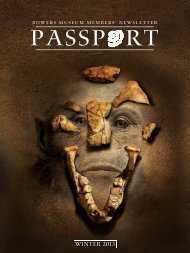A Resource Guide for Students and Teachers - Bowers Museum
A Resource Guide for Students and Teachers - Bowers Museum
A Resource Guide for Students and Teachers - Bowers Museum
Create successful ePaper yourself
Turn your PDF publications into a flip-book with our unique Google optimized e-Paper software.
to consider how artifacts could<br />
deteriorate. Ask the students to list<br />
some items in their home that came<br />
from their gr<strong>and</strong>parents. How are<br />
these items treated? (Hopefully with<br />
respect so they do not get damaged.)<br />
Discuss why families want to preserve<br />
their heritage. Have students list some<br />
items they own that they hope to some<br />
day show to their gr<strong>and</strong>children. What<br />
will they do to be sure these items are<br />
kept safe?<br />
Discuss with the class why artifacts<br />
should be conserved.<br />
Artifacts in a museum are<br />
conserved <strong>for</strong> the “world family.” They<br />
tell about our collective past.<br />
Some techniques to preserve<br />
museum artifacts include:<br />
• H<strong>and</strong>le the objects very carefully<br />
• Keep the artifacts clean by<br />
removing dust, dirt, mold <strong>and</strong><br />
other harmful matter that may<br />
contribute to deterioration<br />
• Do not use harmful chemicals on<br />
or near the artifacts<br />
• Keep artifacts in a display case<br />
which reduces the amount of dust<br />
etc. that can come into contact<br />
with the artifacts<br />
• Keep the light low since some<br />
<strong>for</strong>ms of light cause damage<br />
• Do not allow pictures to be taken<br />
with flash cameras<br />
• Photocopy documents<br />
• Keep the temperature cool<br />
• Look at the artifact regularly<br />
to check <strong>for</strong> signs the artifact<br />
is deteriorating so it can be<br />
stopped or slowed down. Signs of<br />
deterioration are fading colors,<br />
parts loose or missing, <strong>and</strong> insect<br />
infestation<br />
After visiting Terra Cotta<br />
Warriors: Guardians of China’s<br />
First Emperor, discuss which items<br />
seem to be better preserved than<br />
others (such as items made from<br />
rocks <strong>and</strong> more sturdy resources).<br />
13. Legalism vs. Confucianism<br />
Although his systems, st<strong>and</strong>ardizing<br />
writing <strong>and</strong> weights <strong>and</strong> measures,<br />
proved quite beneficial in unifying<br />
his new empire, st<strong>and</strong>ardization<br />
was disastrous <strong>for</strong> philosophical<br />
ideas. The First Emperor outlawed<br />
all schools of thought other than<br />
the officially sanctioned Legalism.<br />
This philosophy assumes that people<br />
are selfish <strong>and</strong> anti-social, <strong>and</strong> that<br />
the state is always more important<br />
than the individual. People must<br />
be harshly punished or rewarded<br />
to behave correctly in a way that<br />
would benefit the state <strong>and</strong> its ruler.<br />
This was a departure from the most<br />
popular school of thought at the time,<br />
Confucianism, which states that the<br />
strength of a government ultimately<br />
is based on the support of the people<br />
<strong>and</strong> virtuous conduct of the ruler. It<br />
emphasizes human goodness <strong>and</strong><br />
social nature, as well as the right to<br />
rebel against those who st<strong>and</strong> in its<br />
way, such as unjust rulers.<br />
The following points can be<br />
covered on a chart, in a comparative<br />
essay, or in a class discussion:<br />
• What are the core ideas of each<br />
philosophy?<br />
• What are the major points of<br />
difference in each?<br />
• Are there any similarities between<br />
the two?<br />
• Find at least one Chinese dynasty<br />
or ruler that employed each<br />
school of thought. How were they<br />
beneficial/detrimental to their<br />
respective societies?<br />
14. Map Activity<br />
Use an outline map of China to<br />
identify the following geographical<br />
features <strong>and</strong> locations:<br />
Cities<br />
• Xi’an<br />
The <strong>Museum</strong> of the Terra Cotta<br />
Warriors <strong>and</strong> Horses is about 36<br />
kilometers (22 miles) east of<br />
Xi’an.<br />
• Beijing<br />
• Tianjin<br />
• Nanjing<br />
• Shanghai<br />
• Guangzhou<br />
• Chongqing<br />
• Hong Kong<br />
Rivers<br />
• Yellow River<br />
• Yangtze River<br />
• Pearl River<br />
Bordering Countries<br />
• Afghanistan<br />
• Bhutan<br />
• Burma<br />
• India<br />
• Kazakhstan<br />
• North Korea<br />
• Kyrgyzstan<br />
• Laos<br />
• Mongolia<br />
• Nepal<br />
• Pakistan<br />
• Russia<br />
• Tajikistan<br />
• Vietnam<br />
Bodies of Water<br />
• East China Sea<br />
• Korea Bay<br />
• Yellow Sea<br />
• South China Sea<br />
• Pacific Ocean<br />
• Philippine Sea<br />
Provinces<br />
• Anhui<br />
• Fujian<br />
• Gansu<br />
• Guangdong<br />
• Guizhou<br />
• Hainan<br />
• Hebei<br />
• Heilongjiang<br />
• Henan<br />
• Hubei<br />
Locate the Three Gorges in this<br />
province. It is southeast of Xi’an.<br />
• Hunan<br />
• Jiangsu<br />
• Jiangxi<br />
• Jilin<br />
• Liaoning<br />
• Qinghai<br />
• Shaanxi<br />
• Sh<strong>and</strong>ong<br />
• Shanxi<br />
• Sichuan<br />
• Yunnan<br />
• Zhejiang<br />
15. Great Wall<br />
There is much visible evidence of the<br />
influence of the First Emperor on the<br />
history of China. Besides the terra<br />
cotta warriors, one can visit the Great<br />
Wall, one of the largest man-made<br />
structures of all time. Parts of the wall<br />
were initially begun be<strong>for</strong>e the time<br />
of the Qin dynasty in order to keep<br />
out invading nomads from the north.<br />
Even though the emperor did not<br />
start the building of these walls, he<br />
contributed a great deal by unifying<br />
<strong>and</strong> exp<strong>and</strong>ing them.<br />
The First Emperor conscripted<br />
labor <strong>for</strong> the job of exp<strong>and</strong>ing the wall<br />
<strong>and</strong> many of these laborers died while<br />
working on the project. It is rumored<br />
that these bodies were buried in the<br />
27





